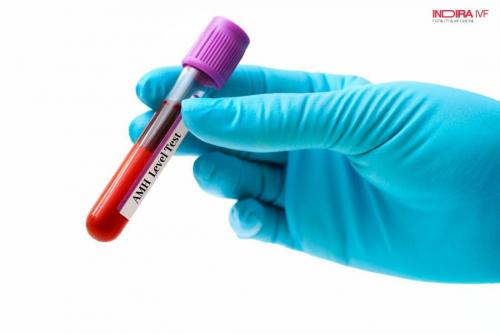Is AMH level test 100% reliable?

The Anti-Mullerian hormone or AMH was discovered in the 1950s by researcher Alfred Jost. Present from the very first weeks of gestation, AMH plays a key role in the formation of the sexual organs of the unborn child. Indeed, between the 8th and the 10th week of pregnancy, the AMH also called Mullerian Inhibiting Substance (MIS) is secreted by Sertoli cells in the gonads (future testes) of male embryos. Its objective is to inhibit the development of the Mullerian ducts which constitute the outline of the uterus, the fallopian tubes and part of the vagina. In parallel, the gonads secrete testosterone which promotes differentiation towards a male genital tract (development of the Wolff ducts). Conversely, in female embryos, Muller's canals develop into the female genital tract, in the absence of AMH.
After birth, AMH can be detected in the following ways:
• In man, in whom it is secreted from uterine life to puberty. During adulthood, AMH remains expressed in the seminal fluid.
• In the woman in whom it appears, after birth, under the action of the granulosa cells of the follicles. Present in very small quantities, it nevertheless plays an important role in folliculogenesis and is, as such, an indicator of the follicular reserve (or ovarian reserve).
What is Low AMH level test?
The answer to what is low AMH test includes the analysis of AMH i.e. Low AMH level test is a key element of the infertility assessment in a couple.
What is AMH test in women?
Indeed, in women, the level of AMH in the blood tends to decrease with age in parallel with the number of follicles, unlike other pituitary hormones (FSH and Inhibin B). As such, the AMH is considered to be the best reflection of the ovarian reserve. In addition, AMH is a good indicator of the success rate of certain protocols for assisted procreation (AMP) and of possible risks of ovarian hyperstimulation. Indeed, there is a correlation between the AMH level (high) and the number of oocytes punctured after ovarian stimulation. Finally, even if its evaluation is not recommended for diagnostic purposes, the AMH level can be (when it is high) an indicator of polycystic ovary syndrome (PCOS). This increase is explained in particular by the increased number of small growing follicles in patients with this syndrome.
What is AMH test in men?
In men, the level of AMH is a good indicator of spermatogenesis. According to research, the level of AMH in the seminal fluid is considerably lower in men with azoospermia than in patients not experiencing fertility problems. In addition, this same rate is correlated with the number of spermatozoa and the volume of the testes. The evaluation of the level of AMH is therefore not only important in the context of a fertility assessment but also extremely useful for specifying a treatment protocol in azoospermic patients since the azoospermia is non-obstructive. The level of AMH is also useful in the research of certain male pediatric pathologies (ectopic testicles, precocious puberty, etc.).
Interpretation of the results of the Low AMH Test-
Recommended in the context of the infertility assessment of a couple, the Low AMH test includes analysis of the serum markers of the AMH must be studied with great caution for several reasons:
• In women, it should be observed with regard to the age of the patient and the count of the antral follicles by ultrasound. Thus, if certain studies have shown that there is an AMH value below the threshold then pregnancies become exceptional for certain women (aged 41/42), others have put forward that a low AMH rate is not a factor excluding young couples (under 30) who are candidates for IVF. Another peculiarity to note: the rate of AMH is not an indicator of the quality of ovulation.
• In humans, the analysis of AMH must be observed in relation to the spermogram and the patient's history in particular.
However, it is generally considered that: In women, the normal level of AMH is between 2.45 and 5.95 ng/ml on the 3rd or 4th day of the cycle. An analysis revealing a threshold below 0.75 ng/ml may be the sign of a possible poor response to a stimulation treatment and should, therefore, be discussed with the practitioner. Finally, an AMH level higher than 6 or 7 ng/ml may also suggest difficulties in conceiving (case of patients with PCOS), but must again be studied on a case-by-case basis.
• In humans, the normal level of AMH is between 1.0 to 4.0 ng / ml.
To know more about various fertility treatments and Low AMH level tests, visit the top fertility centre in India and get all your infertility problems solved.
Post Your Ad Here





Comments